This article will provide a basic overview of just about all of the different types of front suspensions that have been used on production and racing vehicles since the inception of the automobile. While some of the older styles are obsolete it is still important to learn about them because it provides valuable insight into why the cutting edge suspensions of today perform so much better.
| Going in chronological order, the first mass produced front suspension design was the solid beam axle. Just as it sounds, in the beam axle setup both of the front wheels are connected to each other by a solid axle. This style was carried over to the first automobiles from the horse drawn carriages of the past and worked well enough so that initially no other suspension even needed to be considered. In fact the beam axle can still be found today. New developments in springs, roll bars, and shocks have kept the solid axle practical for some applications. Have you ever taken a look at the front end of a semi or heavy duty truck? If you have, you would’ve noticed that both of the front wheels are connect by a solid axle. We’ll make a quick list of the advantages versus the disadvantages for the beam axle front suspension to help understand why it can be used on heavy trucks but is far from desirable on a performance or passenger car. |
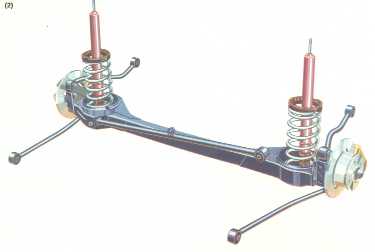 |
| Typical beam axle design, showing the wheels connected by the axle and the whole assembly connected to the chassis by the springs and shocks |
|
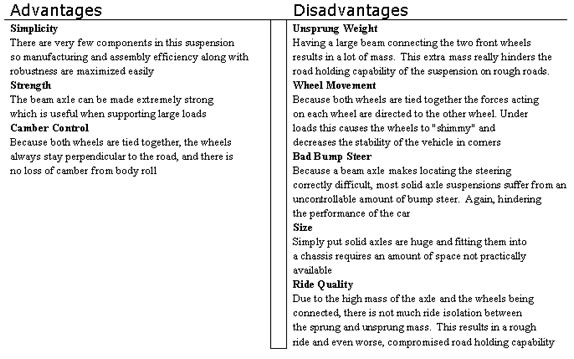 |
| After designers had come to realize the severe drawbacks of the solid axle front suspension, they moved on to early attempts at an independent style of front suspension. One of these attempts came to be known as a swing axle suspension. It is, as the name suggests, set up so that the axles pivot about a location somewhere near the center of the car and allow the wheels to travel up and down through their respective arcs. This system was eventually adapted for rear suspensions as can be found on the old beetles. I’ll use a simple chart to help identify the advantages the swing axle has over the solid axle and highlight some of the shortcomings of this suspension design as well. |
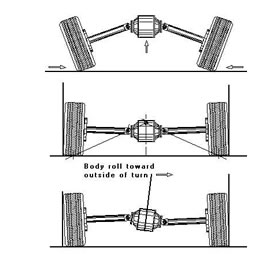 |
| Illustration showing a swing axle suspension at different positions. Notice the huge degree of positive camber when the axles jack up (top) this is what causes the distinct loss in cornering power. |
|
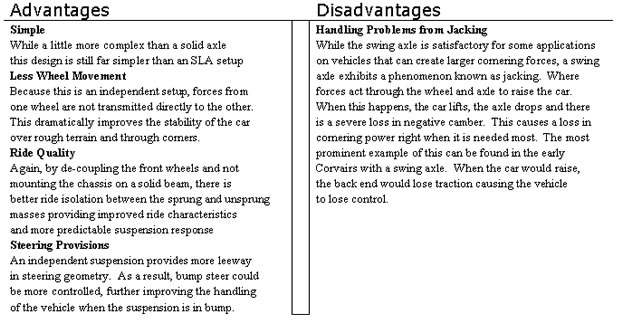 |
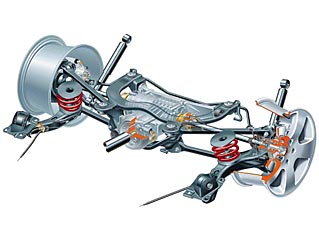 |
| This image shows a single link trailing link rear suspension. While this is not exactly the same as the double link front (due to the differential) the concept is the same. |
|
Another early form of front independent suspension is called the trailing link suspension. This suspension design uses a set of arms located ahead of the wheels to support the unsprung mass. In essence the wheel “trails” the suspension links. Hence the name. Since independent front suspensions were pioneered in production cars to improve the ride characteristics of vehicles as well as minimize the space needed for the suspension itself, early designs like the trailing link suspension attempted to excel in those areas of improvement. Trailing link systems like the one in the front of the old beetle were a success from the manufacturer standpoint as they did improve ride and reduce the packaging size of the suspension. However, there were some considerable drawbacks to the trailing link system when applied to vehicles that generate high cornering loads. |
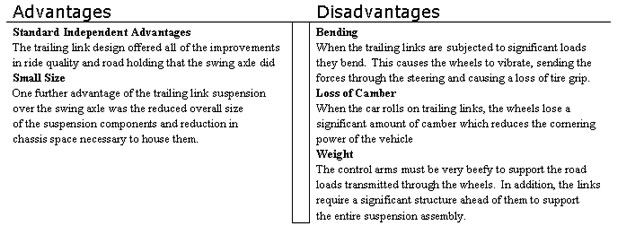 |
| In the 70’s the MacPherson front suspension assembly became a very popular design on front wheel drive cars. This strut based system, where the spring/shock directly connects the steering knuckle to the chassis and acts as a link in the suspension, offers a simple and compact suspension package. This is perfect for small front wheel drive cars where space is tight and even allows room for the drive shaft to pass through the knuckle. Today most small cars will use this type of suspension because it is cheap, has good ride qualities, and has the compact dimensions necessary for front wheel drive cars. As with the trailing link style independent suspension, while the MacPherson assembly works very well for production road going cars, on performance cars it is less than ideal. The chart below illustrates this point. |
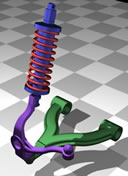 |
| The illustration shows what a typical MacPherson assembly looks like. With the strut acting as the upper suspension link. |
|
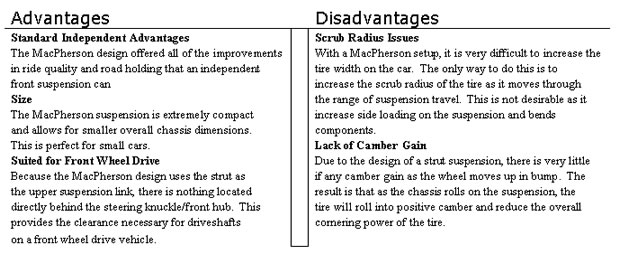 |
The next evolution in suspension design was to move towards the equal length A-arm setup. This is commonly referred to as a “double wishbone” suspension as the A shaped control arms resemble a wishbone. In this design the suspension is supported by a triangulated A-arm at the top and bottom of the knuckle. The earliest designs of the A-arm suspension included equal length upper and lower arms mounted parallel to the ground. This design has many advantages over any of the previous independent front suspensions. The chart below covers these and details the shortcomings of the first generation of double A-arm designs.
 |
After designing, implementing, and experimenting with the equal length double A-arm suspension it was vary apparent that all that was needed to make the double A-arm front suspension satisfactory for high performance use was to determine a way for the suspension to gain negative camber as it was compressed. (I.e. during chassis roll) The problem was solved by implementing upper and lower A-arms of different length. The resulting unequal length double A-arm suspension was born.
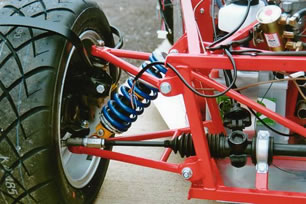 |
| The image shows a typical unequal length double A-arm setup. Note the difference in length between the upper and lower arms. This is what gives this suspension its ability to generate negative camber in bump. |
By using an upper control arm that is shorter than the lower one, as the wheel travels up it tips in, gaining negative camber. This is because the upper arm swings through a shorter arc than the lower and pulls in the top of the tire as the wheel travels upwards. The advantage in this negative camber gain is that as the chassis rolls against the wheels, the increasing negative camber on the outside wheel helps keep the wheel upright against the road surface and allows the tire to generate the maximum possible cornering force. By adjusting the length of the arms and their respective angles to the ground, there are infinite possibilities in the design of a vehicles roll center height and swing arm length. This flexibility gives suspension designers unlimited options on how to best setup the suspension. There is no right answer or best geometry, that is why a Honda will have different geometry than a Corvette. It ultimately comes down to what design will get the vehicle around a corner the fastest. However, in production cars the manufacturers have many other things to consider. Depending on the target market and type of car, there are a host of variables that must be considered and result in a less than optimum suspension design for most vehicles. Lastly, when comparing the unequal length double A-arm setup to all the previous iterations of the independent front suspension from a performance standpoint, it has real no disadvantages and is currently the most advanced suspension design used. Simply look at what suspension the most advanced race cars use if you have any doubts. The only cars that do not feature this design are vehicles where price and space are of more concern than performance.
In summary, we have seen how the evolution of the front suspension has progressed over the past 100 years from the solid beam axle taken from horse buggies through to the unequal length double A-arm design currently employed by the top performance cars of today. While most people have heard that a double A-arm setup is good they don’t know why it is better than a different style of suspension. This article is intended to provide an introduction to the most common types of front suspensions and cover their strengths and weaknesses. After reading through the information presented here you should have a decent understanding of each of the suspension designs discussed and how they affect ride quality and handling performance.

 AF Project Vehicle | Corporate
AF Project Vehicle | Corporate



 AF Project Vehicle | Corporate
AF Project Vehicle | Corporate

